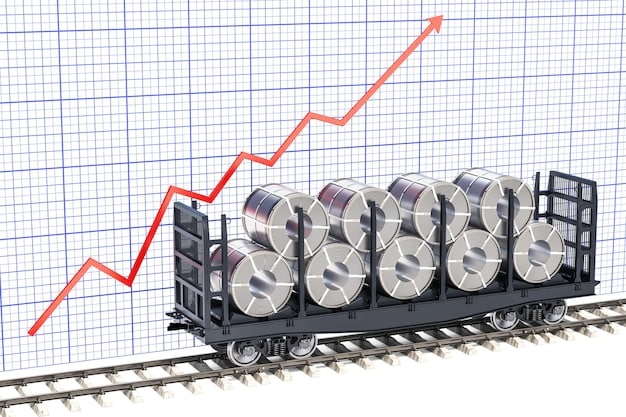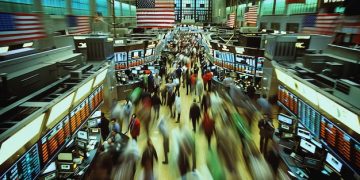Long-Term Impact of Inflation on US Global Competitiveness

What are the Long-Term Effects of the Current Inflation Rate on US Global Competitiveness? Sustained high inflation erodes purchasing power, increases production costs, and can lead to decreased investment and slower economic growth, ultimately weakening the United States’ position in the global market.
The relentless climb of inflation rates has become a major concern for the United States, prompting questions about its lasting consequences. What are the Long-Term Effects of the Current Inflation Rate on US Global Competitiveness? This article delves into the potential impacts, examining how prolonged inflation could reshape the economic landscape and affect America’s standing in the world.
Understanding the Inflationary Landscape
Inflation, defined as the rate at which the general level of prices for goods and services is rising, plays a vital role in shaping economic policies and influencing consumer behavior. Understanding its intricacies is crucial to forecasting its potential long-term effects on US global competitiveness.
Currently, the US is grappling with an inflation rate that has exceeded historical averages, largely driven by supply chain disruptions, increased consumer demand following the COVID-19 pandemic, and expansionary monetary policies. These factors combined have created a complex economic environment, making it essential to look deeper into the challenges and opportunities these inflationary pressures present.
Key Drivers of Current Inflation
Several elements underpin the ongoing inflationary pressures in the US economy. These include:
- Supply Chain Bottlenecks: Disruptions caused by the pandemic continue to hamper the efficient flow of goods, leading to shortages and higher prices.
- Increased Consumer Demand: Stimulus measures and pent-up savings have fueled demand, outpacing the available supply.
- Labor Market Dynamics: Wage growth, driven by labor shortages in some sectors, is contributing to increased production costs.
The interplay of these factors results in a persistent inflationary environment that demands careful study and proactive strategies to mitigate potential adverse effects on the US global position.
In conclusion, the current inflationary landscape is a multifaceted challenge that requires a clear understanding of its drivers and potential impacts. By addressing these issues head-on, the US can strive to maintain its competitive advantage in the global economy.
The Erosion of Purchasing Power

One of the most immediate and visible effects of sustained inflation is the erosion of purchasing power. This means that the same amount of money buys fewer goods and services over time, impacting consumers at all income levels.
As prices rise, households must allocate a larger portion of their budget to essential items like food, energy, and housing. This leaves less disposable income for discretionary spending, savings, and investments, potentially damping economic growth.
Impact on Different Income Groups
The erosion of purchasing power disproportionately affects lower-income households. Key considerations include:
- Regressive Impact: Inflation tends to be regressive, as lower-income families spend a larger share of their income on necessities.
- Decreased Savings: Reduced disposable income makes it harder to save, hindering long-term financial security.
- Increased Debt: Facing higher costs, households may resort to borrowing, increasing debt burdens.
Addressing the erosion of purchasing power requires targeted policies aimed at supporting vulnerable populations and ensuring that the benefits of economic growth are broadly shared.
In summary, the erosion of purchasing power is a significant long-term effect of inflation, impacting consumer behavior and economic stability. By understanding these dynamics, policymakers can develop strategies to mitigate the adverse consequences and promote a more equitable economic environment.
Rising Production Costs and Business Competitiveness
Inflation significantly impacts businesses by increasing production costs. Higher prices for raw materials, energy, and labor can squeeze profit margins, making it more difficult for US firms to compete in the global market.
Companies may respond by raising prices, which can further fuel inflation and reduce demand. Alternatively, they may absorb the higher costs, which can lead to reduced investment, hiring freezes, and even layoffs.

Supply Chain Vulnerabilities
Supply chain issues exacerbate the problem. Highlights include:
- Increased Transportation Costs: Higher fuel prices drive up the cost of shipping goods.
- Material Shortages: Scarcity of key inputs can disrupt production and increase prices.
- Geopolitical Risks: Global instability can further disrupt supply chains, adding to inflationary pressures.
Navigating these challenges requires businesses to adopt innovative strategies, such as diversifying supply chains, investing in automation, and improving operational efficiency.
In conclusion, rising production costs pose a significant threat to business competitiveness in an inflationary environment. By addressing supply chain vulnerabilities and investing in productivity-enhancing measures, US firms can better weather the storm and maintain their competitive edge.
Impact on Investment and Economic Growth
High inflation can deter investment and slow economic growth. Uncertainty about future prices and costs makes it difficult for businesses to plan and commit to long-term projects.
Investors may shift their focus from productive investments to assets that are perceived as hedges against inflation, such as commodities or real estate. This can divert capital away from sectors that drive innovation and economic expansion.
Monetary Policy Responses
Central banks typically respond to rising inflation by raising interest rates. The effects of these policies are:
- Increased Borrowing Costs: Higher rates make it more expensive for businesses and consumers to borrow, dampening investment and spending.
- Reduced Liquidity: Tightening monetary policy reduces the amount of money in circulation, which can slow economic activity.
- Risk of Recession: Aggressive rate hikes can trigger a recession if they overly constrain demand.
Effective monetary policy requires careful calibration to balance the need to control inflation with the risk of stifling economic growth.
In summary, the impact of inflation on investment and economic growth is complex and multifaceted. By implementing sound fiscal and monetary policies, policymakers can strive to create a stable economic environment that encourages investment and sustainable growth.
The Role of Government Policies
Government policies play a crucial role in managing inflation and mitigating its adverse effects. Fiscal measures, such as tax policies and government spending, can influence aggregate demand and supply.
Supply-side policies, such as investments in infrastructure, education, and research and development, can boost productivity and reduce inflationary pressures in the long run.
Fiscal and Monetary Coordination
Coordination between fiscal and monetary authorities is essential for effective inflation management. Critical components include:
- Fiscal Discipline: Controlling government debt and deficits can reduce inflationary pressures.
- Targeted Spending: Investing in areas that boost productivity and supply can alleviate bottlenecks.
- Independent Monetary Policy: Allowing the central bank to operate independently can enhance credibility and effectiveness.
A well-coordinated policy response can help stabilize the economy and promote sustainable growth in the face of inflationary shocks.
In conclusion, the role of government policies in managing inflation cannot be overstated. By adopting a comprehensive approach that combines fiscal discipline, supply-side investments, and independent monetary policy, policymakers can create an environment conducive to stable prices and sustainable economic growth.
Impact on US Global Trade and Competitiveness
Persistent high inflation can significantly impact US global trade and competitiveness. Higher prices for US goods and services can make them less attractive to foreign buyers, reducing exports and widening trade deficits.
Conversely, relatively lower prices in other countries can make imports more attractive, further eroding the competitiveness of US firms. This can lead to job losses and reduced economic activity in export-oriented industries.
Exchange Rate Dynamics
Exchange rates play a crucial role. Consider these factors:
- Currency Appreciation: Higher US inflation can lead to a stronger dollar, further reducing the competitiveness of US exports.
- Trade Imbalances: Persistent trade deficits can put downward pressure on the dollar, potentially offsetting some of the competitiveness losses.
- Global Economic Conditions: Fluctuations in global demand and supply can also affect US trade performance.
Maintaining a competitive exchange rate requires careful management of monetary policy and international economic relations.
In summary, inflation has a notable impact on US global trade and competitiveness, affecting export performance, trade balances, and exchange rate dynamics. Proactive strategies are imperative to maintain trade competitiveness.
Strategies for Maintaining Competitiveness in the Face of Inflation
To maintain global competitiveness in the face of inflation, the US needs to pursue a multi-pronged strategy that focuses on boosting productivity, controlling costs, and enhancing innovation.
Investments in education, infrastructure, and research and development can improve the long-term competitiveness of the US economy. Creating a business-friendly environment that encourages investment and entrepreneurship is also essential.
Innovation and Technology Adoption
Innovation is key to enhancing competitiveness. Important factors:
- R&D Spending: Increased investment in research and development can lead to new technologies and products.
- Technology Transfer: Facilitating the adoption of new technologies by businesses can boost productivity.
- Skilled Workforce: Investing in education and training can create a workforce capable of driving innovation.
By fostering a culture of innovation, the US can maintain its competitive edge in the global economy.
In conclusion, maintaining competitiveness during periods of inflation involves strategic investments in productivity enhancements and business-friendly policies. By embracing innovation, skill development, and effective cost management, the US can bolster its position in global markets.
| Key Point | Brief Description |
|---|---|
| 💸 Purchasing Power | Inflation reduces the value of money, impacting consumer spending habits. |
| 🏭 Production Costs | Higher costs for raw materials and labor affect business profitability. |
| 📈 Investment & Growth | Inflation can deter investments, slowing down overall economic growth. |
| 🌎 Global Trade | Competitiveness can be eroded as exports become more expensive. |
Frequently Asked Questions
▼
Inflation reduces the purchasing power of money, meaning consumers can buy fewer goods and services with the same amount of money. This especially impacts essential items like food and energy.
▼
The Federal Reserve manages inflation primarily through monetary policy, such as adjusting the federal funds rate and conducting open market operations. These actions influence borrowing costs and the money supply.
▼
Disruptions in the supply chain lead to shortages of goods, causing prices to rise due to increased demand and limited availability. This can affect a wide range of products and services.
▼
Businesses can combat inflation by improving operational efficiency, diversifying their supply chains, and investing in technology to reduce costs. They may also need to adjust pricing strategies.
▼
Government policies can help control inflation through fiscal discipline, targeted investments in productivity-enhancing areas, and coordination with monetary policy to ensure a stable economic environment.
Conclusion
In conclusion, the enduring effects of present-day inflation on US global competitiveness present a complex challenge encompassing purchasing power, production costs, investment dynamics, and trade balances. Implementing well-coordinated fiscal and monetary policies, combined with strategic investments in innovation and productivity, is essential for maintaining America’s competitive position in the global market.





